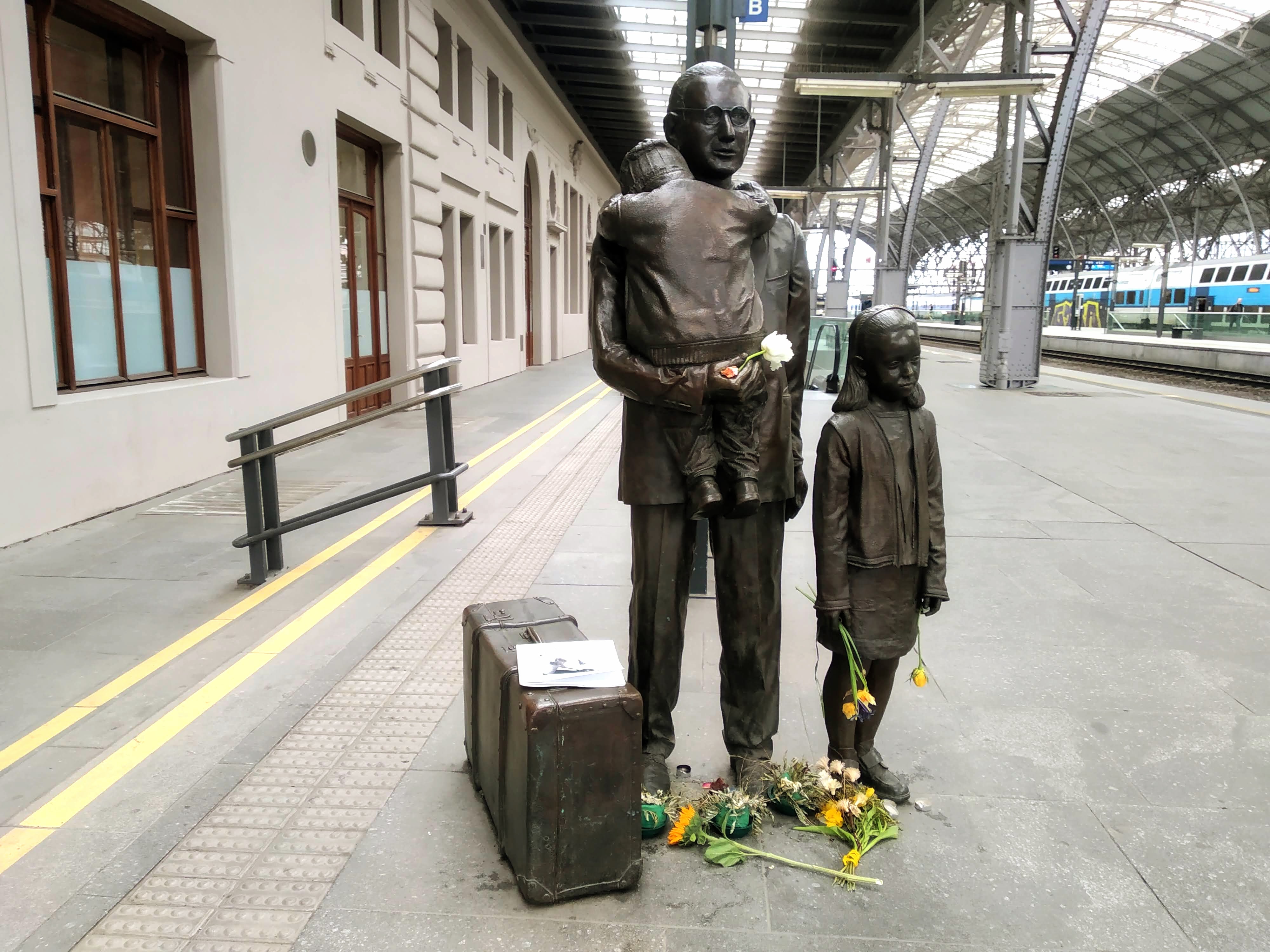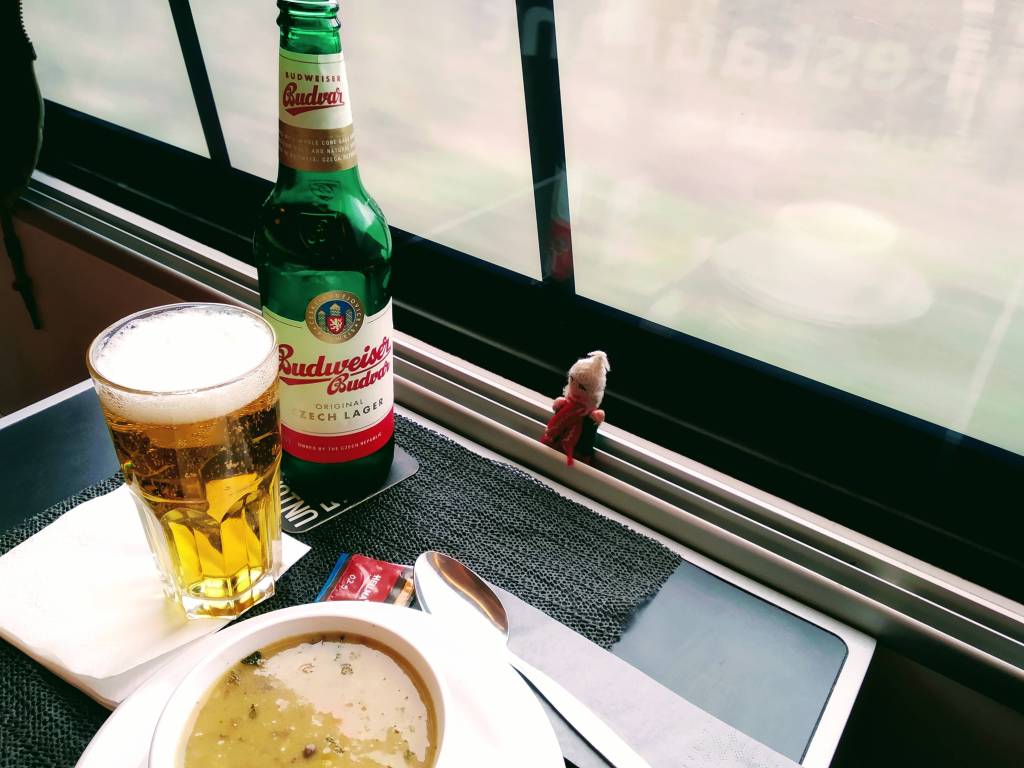Two months, day forty-three: Prague - Brno
Oooh. Hello Railjet.

Check out at my hotel was an hour earlier than I thought it was.
Although my free breakfast was a most leisurely affair, my departure from the hotel was, as a result of my miscalculation, most definitely not. This was, perhaps, in part to the fact that the staff in the breakfast room were slightly over-zealous and every time I left my table to get more food, I came back to discover my previous dining place devoid of any trace of my having been there. This hindered a more rapid breakfast progress and made it last much longer than it should have, particularly with regard to coffee, but I got through my scrambled eggs, bread and honey, and pancake eventually before a quick shower and a dash downstairs to vacate pretty much on the dot of ten.

There was some random walking around in the morning, perhaps in an attempt to get a thousand steps, until I realised that once you've seen the arse of a red plastic giraffe with a showerhead for a face, there's nothing left in life to see. I immediately took the underground to the central station where Berlin Host, who arrived yesterday on the train I would've been on, joined me in looking around the station taking photographs of things.
In particular, I was keen to see the tribute to Sir Nicholas Winton, having only learned of its (and indeed his) existence after passing through the station last time I was here. Berlin Host joined in this endeavour.

A British stockbroker, Nicholas Winton travelled to Prague in 1938 aged 29 and spent three weeks clandestinely compiling a list of child refugees, mostly Jewish, who had been displaced from Germany. On his return to Britain, he made arrangements for 669 children to leave Czechoslovakia and to be placed with families in Britain.
Following the takeover of Prague in March 1939 it was no longer possible to fly children out (the last flight left on March 14, the day before German troops marched into the city) and therefore trains became the only possible means of transport. In total, seven Kindertransport trains left Franz Josef Station (now Prague Hlavní Nádraží) bound for Liverpool Street Station, taking children away from a tragic future; as the majority of the children Winton saved were Jewish, it is believed this saved them from certain death had they stayed in Czechoslovakia. The last group of children were due to leave on 3rd September 1939, but could not because of the outbreak of war.
The transport and the organised rescue effort are referred to as Kindertransport.
The monument, unveiled on 1st September 2009, depicts a man (Winton) with two children getting ready to depart the station, and a suitcase. The girl standing next to him is sad, showing that despite being saved, departure was a great cause of sadness for the children who were leaving their families behind and travelling into the unknown.

After some more station exploration we took coffee under the dome of the Art Nouveau section of the station, the largest Art Nouveau monument in in the Czech Republic. It was built between 1901 and 1909 and was the main passenger concourse until 1970, when the underground station opened. From our previous explorations of the exterior of the building we could make out comfy-looking chairs in what must have been lounges set aside for people more important than us. It's easy to see why it was referred to as the 'chateau station'.
I remember looking at the cathedral in Brno from the train to Prague from Budapest and wondering whether it was worth a visit or not. This is why I decided to travel to Brno.

Railjet 79 left platform four on time bound for Vienna, but my stop was Brno. The joruney was comfortable and smooth, and as it was Happy Hour in the dining car I had a starter and a main course and a beer for little more than 12€. This was all served on proper plates and, in the case of the beer, in a proper glass. It was magnificent and ensured I didn't have to eat on arrival. As things were mostly last-minute, I chose a hostel in Brno right next to the station, under the tracks via a slightly sketchy tunnel, which couldn't have been more convenient unless it had been like the hostel in Norrköping.
I was excited because this was my first ever hostel experience. Previously, with paid-for accommodation, I've had private rooms in hostels but shared bathroom facilities. This time, because it was so cheap, I paid about ten euros for a bed in a mixed room of four. There were two other people in the room but they were out for most of it of the day and only there to sleep. Like me. That Backpack fitted nicely into the locker. The bathroom was good.
Brno is a bit tatty, but could arguably be referred to more complimentarily as shabby chic. I was astonished by the visible displays of intoxication and on more than one account was relatively sure I could smell solvents.
That said, I didn't feel uncomfortable or unsafe wandering around, and in fact the most aggressive encounter I had was with a woman in a gift-shop whose fervent use of the English language enabled her to practise reciting the list of everything, and I mean everything, I could buy in her magnificent emporium of tat eventually drove me out of the place. I tried explaining that I only wanted a fridge magnet by only trying to buy a fridge magnet, but she didn't seem to care, and in fact seemed affronted that I might not want to buy the entire shop.
When Mrs Cashonly told me exactly where to find a cashpoint (I'm surprised she didn't march me there at gunpoint) and how long I had to complete my purchase to her satisfaction and, in case I hadn't understood, that I could also buy a wide selection of toys for children downstairs, I decided I needed to leave and that Brno will forever leave a hole on my fridge door.

I was very lucky in getting to the cathedral just as something was finishing and the organist was amusing himself by trying to deafen any remaining stragglers out of the building. Referred to as 'Petrov' by the locals who use the name of the hill it sits upon, the 14th-century Gothic exterior is topped off my two impressive towers. Inside everything is really rather reserved, a rare treat considering the Rome connection, which allows the enormous stained glass windows in the chancel to dominate. The fact that I made it in time to hear the acoustic being put through its paces and to see something pretty vindicated my decision to visit.
To fill a snacky hole in the evening I found a place selling Empañadas which I washed down with a couple of nice-and-cheap pints of Guinness in a bar near the cathedral. I wandered down Petrov via the ramparts and arrived at my hostel intact, made online reservations for the train to Krakow and then went to bed.
